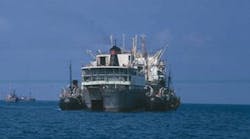A NIOSH assessment of workplace hazards in the Distant Water Tuna Fleet found that workers in the fleet face a higher risk of fatal injuries than workers in most other U.S. fishing fleets.
While falling overboard is the leading cause of death, NIOSH researchers also concluded that workers are at risk of head injuries, asphyxiation and amputations of fingers.
In its report, NIOSH provides a number of recommendations, including:
- Wearing personal flotation devices and appropriate footwear when working on the vessels.
- Conducting monthly emergency drills for responding to falls overboard.
- Following proper procedures when entering confined spaces.
- Ensuring communication between ships officers and crew during emergencies to prevent traumatic injuries to workers.
The Distant Water Tuna Fleet size has grown from 14 vessels in 2006 to 39 vessels in 2012. The fleet operates in remote locations, which makes rescue and medical response challenging, NIOSH noted.
NIOSH, by request of the U.S. Coast Guard, conducted the evaluation of the Distant Water Tuna Fleet to examine fatal and non-fatal traumatic injuries and provide recommendations for preventing future injuries and fatalities.
The NIOSH report provides a baseline assessment of the current injury and fatality rates for the fleet, along with specific safety recommendations for employers and workers.
NIOSH said it hopes to conduct a follow-up analysis in the future to determine if the recommendations were implemented and, if so, what impact they have had on fatality and injury rates for this fleet.
